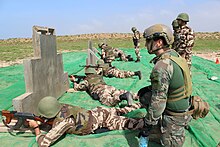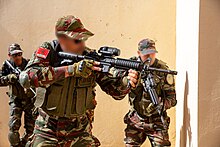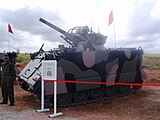Royal Moroccan Army
This article needs additional citations for verification. (May 2020) |
The Royal Moroccan Army (
The Royal Moroccan Army is about 215,000 troops strong and consists of 195,000 professional soldiers and 20,000 conscripts.[2] In case of war or state of siege, an additional force of 150,000 Reservists[citation needed] and paramilitary forces, including 24,000 regulars of the Royal Moroccan Gendarmerie and 30,000 Auxiliary Forces come under the Ministry of Defense command.
Army forces from Morocco have taken part in different wars and battles during the twentieth century, from
History





The Moroccan army has existed continuously since the rising of
The
The Royal Armed Forces were created on 14 May 1956, after
The first wars that Moroccan troops have taken part in the 20th century as an independent country were the Ifni War and Sand War.
In the early 1960s, Moroccan troops were sent to the Congo as part of the first multifunctional UN peacekeeping operation,
The Royal Moroccan Army fought during the Six-Day War and on the Golan front during the Yom Kippur War of 1973 (mostly in the battle for Quneitra) and intervened decisively in the 1977 conflict known as Shaba I to save Zaire's regime.[5][6][7] After Shaba II, Morocco was part of the Inter-African Force deployed on the Zaire border, contributing about 1,500 troops.[8] The Armed Forces also took part in the Gulf War with a Mechanized Battalion and an infantry battalion in the Omar and Tariq Task Forces.
In the 1990s, Moroccan troops went to Angola with the three UN Angola Versification Missions,
Recent United Nations deployment in Africa and elsewhere have included the
Other missions have included:[citation needed]
- Perejil Island crisis
- International Security Assistance Force Joint Command
- Operation Scorched Earth
- MINUSTAH
- United Nations Supervision Mission in Syria (UNSMIS)[9]
Algeria, Morocco, and other Maghreb states affected by the
Army of Liberation
The Army of Liberation (
The revolt in the Spanish Sahara was put down in 1958 by a joint French and Spanish offensive. The king of Morocco then signed an agreement with the Spanish, as he asserted control over the rebellious southern border areas, and parts of the Army of Liberation was absorbed back into the Moroccan armed forces.
Forces today
Situation and equipment

From the beginning of 21st-century, the Moroccan army began a modernisation program that included the purchase of modern equipment and the transformation into a more professional army performing multiple exercises with allied armies, and as a Major non-NATO ally of the US, and member of the initiative 5+5[10] and other cooperation agreements. The army's modernisation program took shape with the acquisitions of weapons such as the Chinese VT-1A and MRLS AR2, American M1A1 Abrams, the HAWK air defense system or the M109A5 Self-Propelled Howitzer.
The organisation and structure of command remained the same:
- General Command HQ (Rabat)
- Northern operational Sector.
- eastern Command HQ (Errachidia)
- Eastern operational sector
- Tafilalt operational sector
- Saghro operational sector
- Southern Command (Agadir)
- Oued draa operational sector.
- Sakia El Hamra operational sector.
- Oued eddahab operational sector.
Formations are as follows:
- 2 Airborne infantry brigades.
- 15 Motorised infantry brigades/Regiments.
- 3 Royal Armored brigades.
- 13 Royal tanks regiments.
- 6 mechanised infantry brigades.
- 24 Royal Artillery groups(4 Ground to air Groups/2 Rocket artillery groups/18 field artillery groups)
- 1 light security brigade.
- 1 mechanised intervention brigade.
- 1 mountain infantry battalion.
- 2 Royal cavalry regiments.
- 12 Borders surveillance battalions.
- 17 intervention light infantry battalions.
International projection

The Kingdom of Morocco is part of multiple international organisations, is a
The Royal Moroccan Army also performs annual training exercise called "African Lion" with the United States Marine Corps. The exercise is a regularly scheduled, combined U.S. - Moroccan military exercise designed to promote improved interoperability and mutual understanding of each nation's tactics, techniques, procedures, unit readiness and enhancing foreign relations.
Morocco has also been the venue for Exercise "Jebel Sahara" since September 2000, taken 10 times since, and gathering elements from 33 Squadron, 230 Squadron, 18 Squadron, 27 Squadron, Joint Helicopter Force HQ from RAF Benson, 1st Battalion Royal Gibraltar Regiment and 2nd Brigade d'Infanterie Parachutiste of the Royal Moroccan Army. The aim of the Exercise was to increase the Support Helicopter warfighting capability in desert 'hot and high' conditions and foster good relations between the UK and Morocco. To achieve this, the scenario consisted of a joint counter insurgency operation in the desert and mountain foothills to re-establish control and authority within a troubled region of North Africa.[19] Another exercises were the "Jebel Tarik", with the Moroccan contribution of service personnel to an annual bilateral deployment of two companies (up to 180 personnel) of the Royal Gibraltar Regiment (RG) to the UK, on seven occasions since 2003.[20] "Desert Vortex", a one-off bilateral helicopter exercise which is run between 16 May and 30 June 2009. This was a UK training exercise with objectives set by Joint Helicopter Command (JHC) and run concurrently with Moroccan Air Force annual helicopter crew training.[21]
The Royal Gibraltar Regiment ran an exercise with the Moroccan 2e Brigade d'Infanterie Parachutiste (2e BIP) in late 2008.[22]
The Royal Armed Forces also take part of different international exercises as Leapfest,[23] Flintlock,[24] Blue Sand,[25] and occasional military operations exercises with Belgium, U.A.E., Spain, France and others.
Ranks and structure
Officers
| Rank group | General / flag officers | Senior officers | Junior officers | Officer cadet | ||||||||||||||||||||||||||||||||
|---|---|---|---|---|---|---|---|---|---|---|---|---|---|---|---|---|---|---|---|---|---|---|---|---|---|---|---|---|---|---|---|---|---|---|---|---|

|

|

|

|

|

|

|

|

|

|

|

| |||||||||||||||||||||||||
| Maréchal | Général d'armée | Général de corps d'armée | Général de division | Général de brigade | Colonel-major | Colonel | Lieutenant-colonel | Commandant | Capitaine | Lieutenant | Sous-lieutenant | |||||||||||||||||||||||||
- Général de l'armé et commandant en chef: Retained by His Majesty the King of Morocco.
Enlisted
| Rank group | Senior NCOs | Junior NCOs | Enlisted | |||||||||||||||||||||||||||||||||
|---|---|---|---|---|---|---|---|---|---|---|---|---|---|---|---|---|---|---|---|---|---|---|---|---|---|---|---|---|---|---|---|---|---|---|---|---|

|

|

|

|

|

|

|

|

| ||||||||||||||||||||||||||||
| Adjudant-chef | Adjudant | Sergent-major | Sergent-chef | Sergent | Caporal-chef | Caporal
|
Soldat de première classe | Soldat de deuxième classe | ||||||||||||||||||||||||||||
In 2009, the Moroccan army had:[27]
Equipment

Uniform
The most common service uniform of the Royal Moroccan Army is olive drab, but you can also see Moroccan troops with other types of uniforms such as the Desert lizard, Red Lizard and Camouflage Central-Europe uniforms.The uniform has been changed into a newer and modern one :
-
Moroccan Soldiers with Olive Drab Battle Uniform and SPECTRA helmet
-
General Abdelaziz Bennani with Camouflage Central-Europe Camo Battle Uniform
-
Moroccan soldiers with Desert lizard Camo Battle Uniform
See also
References
- S2CID 232050772.
- ^ "الخدمة العسكرية.. تكوين 20 ألف مجند في 2022 سيُكلف أزيد من 55 مليار سنتيم". al3omk.com (in Arabic). Retrieved 26 December 2021.
- ^ "UN Secretary General Grateful to Morocco for Action for Stability in Central African Republic". www.moroccanembassy.sa.
- ^ "Africa :: Morocco – The World Factbook - Central Intelligence Agency". www.cia.gov. 12 January 2022.
- ^ Science, London School of Economics and Political. "404". London School of Economics and Political Science.
{{cite web}}: Cite uses generic title (help) - ^ "National Intelligence Daily (Cable) : 5 June 1978" (PDF).
- ^ "National Intelligence Daily (Cable), 27 novembre 1978" (PDF).
- ISBN 92-9045-133-5.
- ^ "UNSMIS Facts and Figures".
- ^ "Spanish ministry of defense website".
- ^ The U.S. cooperation program in Morocco is a model for the region and is an important aspect of on-going regional multilateral security cooperation activities, including peacekeeping operations. Requested FY 2010 funding will allow the U.S. to meet a target of assisting Moroccan military personnel participation in 50 exercises with U.S. or coalition forces."Archived copy" (PDF). Archived from the original (PDF) on 24 October 2014. Retrieved 5 October 2012.
{{cite web}}: CS1 maint: archived copy as title (link) - ^ In Moscow, the signing of the Agreement between the Government of the Russian Federation and the Government of the Kingdom of Morocco on cooperation in military field [1]
- ^ No que se refere ao objetivo 3, em 2011, foram realizadas 13 atividades com Marrocos [2]
- ^ "La Presse de Tunisie - limperatif-dimpulser-davantage-la-cooperation-militaire | 23389 | 25022011". 1 March 2011. Archived from the original on 1 March 2011.
- ^ "Échanges franco-marocains - French ministry of defense". Defense.gouv.fr. Retrieved 26 March 2019.
- ^ "Réunion à Rabat de la 7e commission mixte militaire maroco-espagnole". Archived from the original on 22 July 2012.
- ^ "Morocco Sends Humanitarian Assistance to Refugees at the Libyan Border".
- ^ "Security Council, Meeting on Situation in Syria, Shifts Focus to Plight of Externally, Internally Displaced Persons | Meetings Coverage and Press Releases". www.un.org.
- ^ "Archived copy" (PDF). Archived from the original (PDF) on 7 December 2011. Retrieved 15 December 2011.
{{cite web}}: CS1 maint: archived copy as title (link) - ^ "Panorama Home Page".
- ^ "House of Commons Hansard Written Answers for 08 Dec 2010 (pt 0001)". publications.parliament.uk.
- ^ 'African Adventure,' Air International, January 2009, p.58
- ^ "Army National Guard". www.nationalguard.com.
- ^ http://207.58.148.253/category.php?NID=60073
- ^ "Blue Sands exercise challenges bluesuiters". Archived from the original on 19 April 2012. Retrieved 12 October 2011.
- ^ LCCN 85600265. Retrieved 16 September 2023.
- ^ M Sehimi (12 June 2009). "Qui dirige l'armée au Maroc ?". Maroc Hebdo. Retrieved 13 February 2014.
Further reading
- Anthony Cordesman, 'A Tragedy of Arms'
- John Keegan "World Armies" ISBN 0-333-17236-1
- R. Hure "L'Armee d' Afrique 1830-1962"







